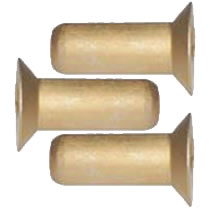
Solid rivets play an important role in the aerospace industry. Consisting of a cylindrical shaft and a mushroom-shaped head, they are designed to permanently hold two or more parts together. A hole is initially drilled through the parts, after which a solid rivet is inserted. A bucking bar is then placed against the back of the rivet. Striking the head of the hammer will cause the back of it to collapse, thus holding the parts together. While all solid rivets feature a shaft and head, however, you can find them in different materials.
Aluminum
One of the most common materials in which solid rivets are made is aluminum. They are lightweight, durable and relatively inexpensive compared to rivets made of other materials. Aluminum steel rivets are also highly resistant to corrosion. Since they don’t contain iron, they can’t rust.
Some aluminum solid rivets are alloyed with other elements like zinc, magnesium or copper to improve their strength. Others are made entirely of aluminum. Regardless, aluminum is a popular material for solid rivets.
Steel
Steel is commonly used in the construction of solid rivets. Steel is an iron alloy. Like other iron alloys, it’s made by mixing iron with other elements. Steel specifically contains iron with less than 2% carbon. Other elements like manganese, nickel, cobalt or chromium may be included, but all steel contains two main elements: iron and carbon.
Steel solid rivets offer a superior level of strength. They are stronger than their aluminum counterparts, making them ideal for use in construction-related applications. The downside to steel solid rivets, though, is their weight. Since steel is about 2.5 denser than aluminum, steel rivets weigh more than aluminum rivets.
Copper
In addition to aluminum and steel, copper is used to make solid rivets. Copper solid rivets offer excellent resistance to corrosion. Even when regularly exposed to moisture, they typically won’t corrode. Copper solid rivets are also strong yet soft.
They aren’t as common as aluminum or steel, but some solid rivets are still made of copper. The soft properties of copper makes them easy to install. Installation requires deformation. You must deform the back of a solid rivet so that it bends around the parts with which it’s used. Copper solid rivets will easily deform when struck with a hammer thanks to their solid core.
In Conclusion
Solid rivets are characterized by a solid core. The core of the shaft is made of solid material, such as aluminum, steel or copper. Each of these materials offers its own benefits. In the aerospace industry, however, aluminum solid rivets are most popular.



